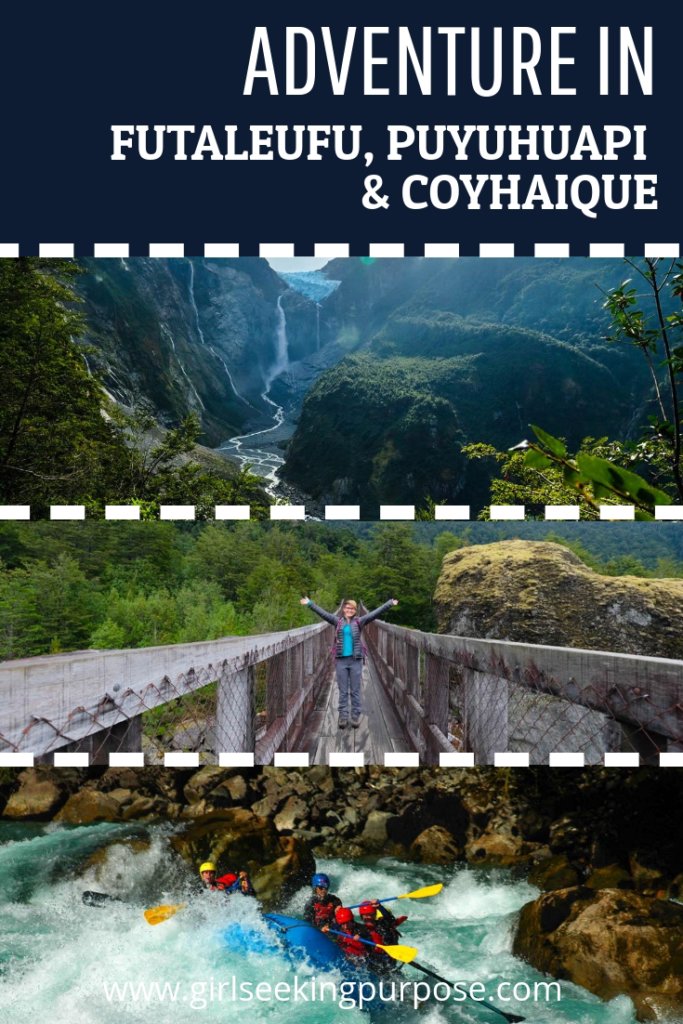
Adventure in Futaleufu, Puyuhuapi and Coyhaique on the Carretera Austral in Patagonia, Chile.
Now that I’m back in Australia for a little while I will be able to update you all a bit more regularly about my incredible adventures. While I was still in South America I had already kick started my posts about Patagonia. I figured that would be a great place to continue from. If you want to read from the beginning of my posts about Patagonia then you should check out these posts about Refugio Frey, the best hikes in Bariloche, and camping and hiking in Pumalin Park. My 10 week update on New Zealand, Chile, Bolivia and Patagonia also gives a great overview of where I went and what I experienced during my time in this beautiful section of the globe.
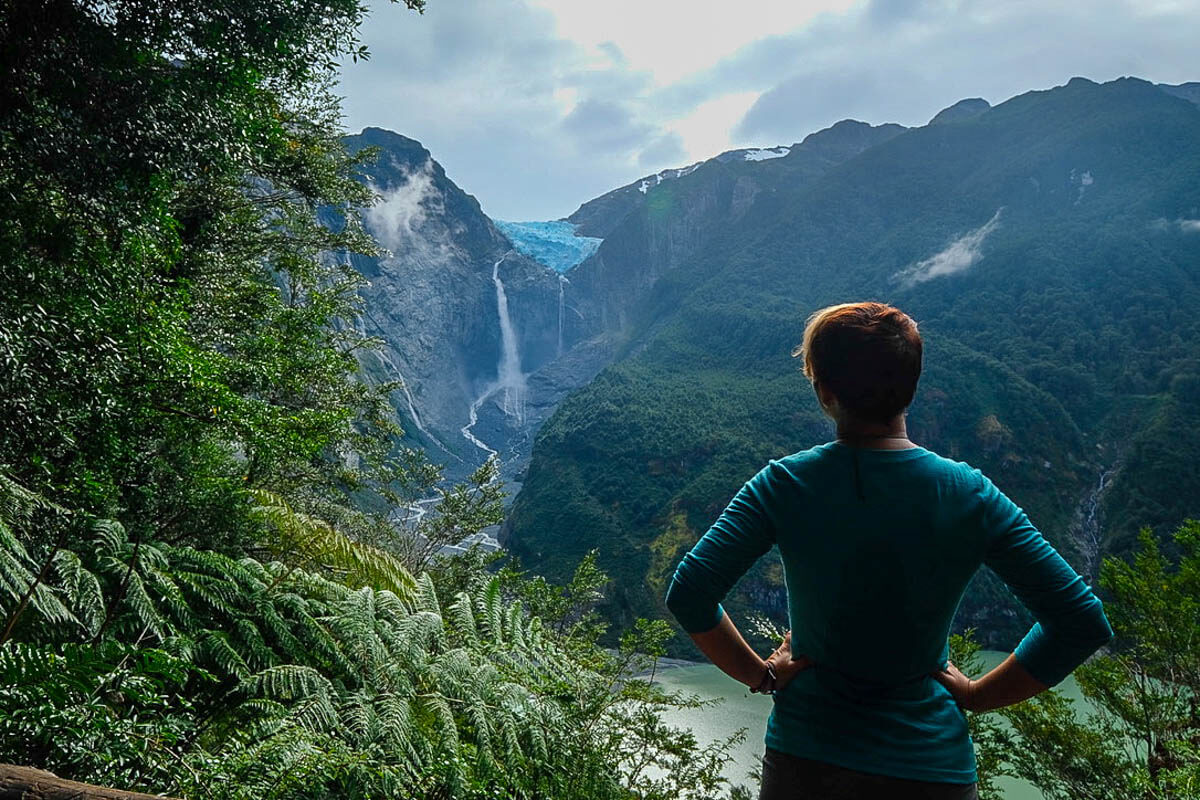
Adventure awaits at the Queulat Hanging Glacier on the Carretera Austral in Chile.
For today’s guide I want to take you again to the stunning remote highway in Chilean Patagonia; the Carretera Austral. This was by far one of the best parts of my entire trip. As you continue down the Carretera Austral from Pumalin Park you will find yourself coming across more and more places full of adventure. The next three big stops along this beautifully remote highway are Futaleufu, Puyuhuapi and Coyhaique. Each of these places have their own unique adventure draw cards and are necessary stops along your way down to Southern Patagonia.
Rafting Adventure in Futaleufu
What to Do
This is definitely one of the adventure capitals of Chile, particularly if you are into water sports. Futaleufu river is ranked in the top three best rivers in the world for white water rafting along with rivers in Colorado and Zambia. There are a variety of companies operating out of the town. They all offer a range of difficulty levels from beginners, to intermediate and then more advanced for the true adventure junkies.
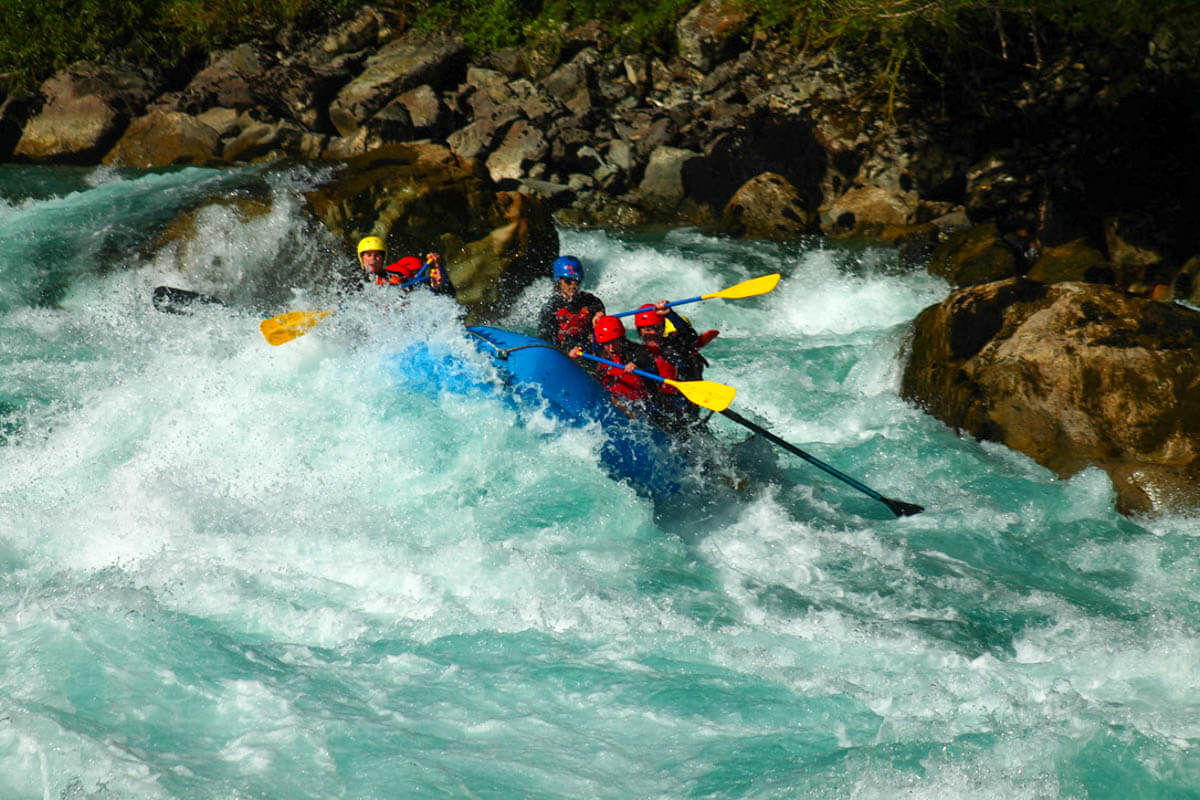
Getting smashed on one of the first rapids down Futaleufu River on the Carretera Austral.
After speaking with a very experienced white water rafter I met in Chaiten, he convinced me to head straight to Outdoor Patagonia to book my rafting day. And that is exactly what I did. They were very professional, friendly and their photographer was amazing. The meal they provided when we got back to town was delicious local cuisine and an added bonus.
The Cost
The cost for a half day of class IV and V rapids was $50,000.00 CLP ($108.00 AUD). You can also choose to add a couple of extra class V runs in at the end of the river for an additional $15,000.00 CLP ($32.00 AUD). I highly recommend adding the extra section as this was one of the most exciting and fun parts of the run.
What’s Included
The price includes all of your safety gear, wetsuit, booties and instructions at the start. The guides who go on the raft with you are very experienced and speak both Spanish and English. Once you return you can also pay for the group professional photos, costing around $3,000.00 CLP ($6.50 AUD) per person. The photographer is out on the water with you in a white water kayak getting all of the best action shots. The photos are definitely worth getting and I love all of mine.
Where to Stay
There are a variety of options for accommodation in Futaleufu, as it is one of the more tourist driven towns along the Carretera Austral. In saying that though, this town is still barely considered a tourist town given it’s remote location. It still has a beautiful, small, remote town feel to it and is surrounded by a gorgeous mountain backdrop.
Hostel
In addition to being an adventure company, Outdoor Patagonia is also a hostel, bar and restaurant so this could be an all in one option if you don’t have camping gear with you. This will be a more expensive way to go though, at around $14,000.00 CLP ($30.00 AUD) per night.

Nothing but smiles, the whole way! Psstt – I’m the one with the yellow helmet!
Camping
If you are wanting to save some money, meet some more locals and practise your Spanish then I would recommend camping while in Futaleufu. This is what I did, and it was a large part of the adventure and fun while I was there. It also allowed me to really dig deep into the local culture and get some off the mountain use out of my tent.
A lot of the campsites are in locals’ backyards. They have converted their properties to provide electricity, running water, showers and toilets. This style of accommodation also means you will be paying only $3,000.00 to $5,000.00 CLP ($6.50 to $11.00 AUD) per night. You can also negotiate a cheaper price if you stay multiple nights or with a group of people. An added bonus of the campsites is that it is a great opportunity to meet some local Chilean people. Residents of the cities, Santiago and Concepcion often travel south on camping trips to the Carretera Austral around the summer months. You will be sure to meet a few if you take the camping option.
Best Time to Go
As with most river adventure spots the best time of year to go is in the Spring from September to November. This is when the river is the fullest. This will mean that all of the rapids are at their best. Summer, from December to February is also perfect as you will have a lot of beautiful sunny days and the rapids will still be amazing. You can also go in the shoulder season towards the end of Summer and beginning of Autumn. Don’t leave it too late though or the rapids will have slowed down too much. The Carretera Austral will also begin to close down to tourism if it gets too close to Winter.
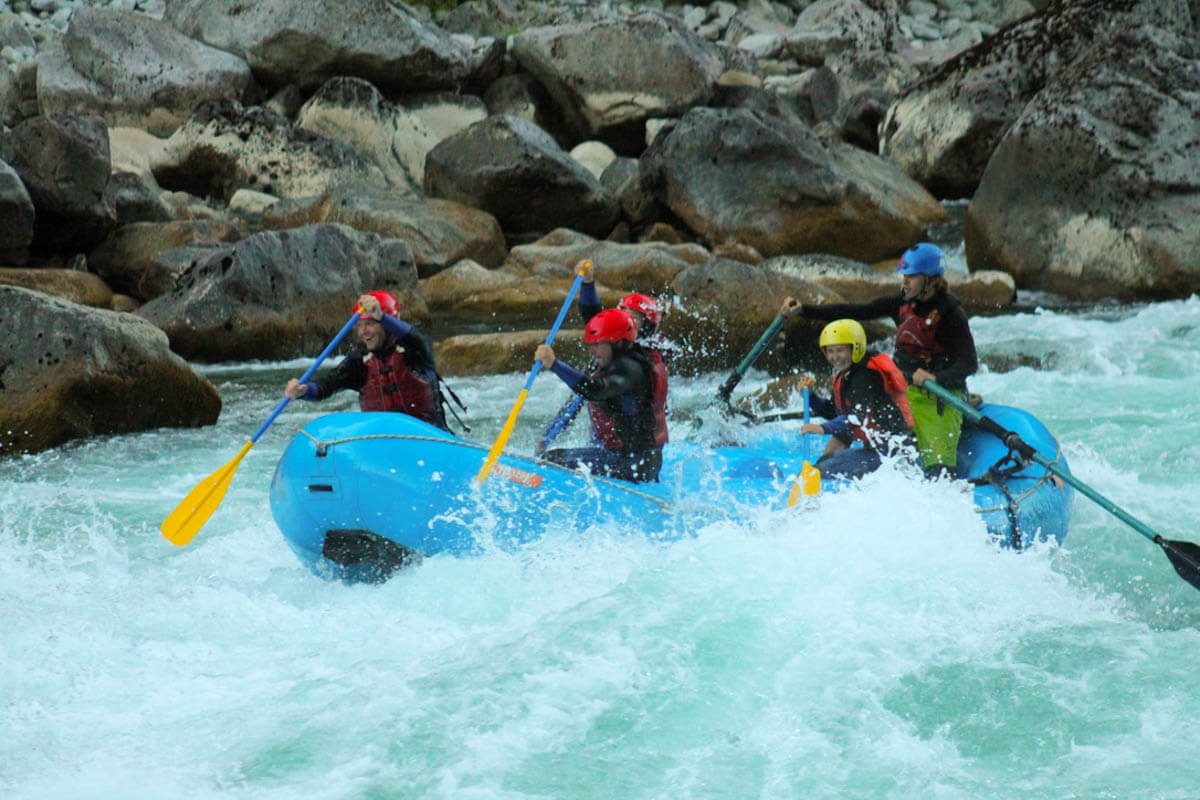
Less people, I know, but we didn’t lose them. They just didn’t want to brave the REALLY BIG rapids!
Getting There and Away
If you have already been to Pumalin Park then this is the next stop on your way South along the Carretera Austral. As mentioned in my previous post on Pumalin Park, you can catch a bus from Chaiten to Futaleufu for $4,000.00 CLP ($8.50 AUD). Getting to the next stop along the way, Puyuhuapi is a little more challenging than previous stops in Patagonia. While there are no direct buses from Futaleufu to Puyuhuapi, it isn’t impossible.
You can catch a bus from Futaleufu to Villa Santa Lucia. This town is located in between Chaiten and La Junta for around $1,500.00 CLP ($3.00 AUD). Once you reach Villa Santa Lucia you can wait for the bus that is travelling from Chaiten to La Junta and get on halfway. These are not frequent or guaranteed so another option is to hitchhike from Villa Santa Lucia to La Junta, or if possible as far as Puyuhuapi. This is the option I took and it was a lot more fun than a bus anyway.
Hiking Adventure in Puyuhuapi and the Queulat Hanging Glacier
Puyuhuapi
When you arrive in Puyuhuapi you will see a tiny, quaint little village on the water surrounded by fjords. It is quite the spectacle and the main access point for the hiking adventures of the Queulat National Park. This is a good spot to fill up on cooking supplies for the national park. There is a tiny mini-market, a butcher and a bakery on the main street. These three shops should have all you need for the next few nights.
Once there, you can then decide whether you want to stay the night here or camp inside the Queulat National Park. This will likely depend on where your hitchhiking lift is headed. It may also depend on how long you plan to stay and how in love you are with the tiny town. We were lucky that the people who picked us up needed supplies from the town and were also camping in the National Park so we were able to get a lift to both.
Queulat National Park Entrance and Camping
If you opt to camp inside the national park then you need to ensure you arrive at the park ranger checkpoint prior to 5.00pm. They do not allow access after this time to the hikes or camping and are very strict with the timing. We almost weren’t let in at 5.03pm until my Chilean friend negotiated safe passage for us!!
The entrance to the National Park is $5,000.00 CLP ($11.00 AUD) and only needs to be paid once for the duration of your time there. The camping is an additional $5,000.00 CLP ($11.00 AUD). It includes sectioned off camp sites, a cooking shelter, running water, a shower and toilets. These showers have hot water but only during certain times.
Queulat Hanging Glacier
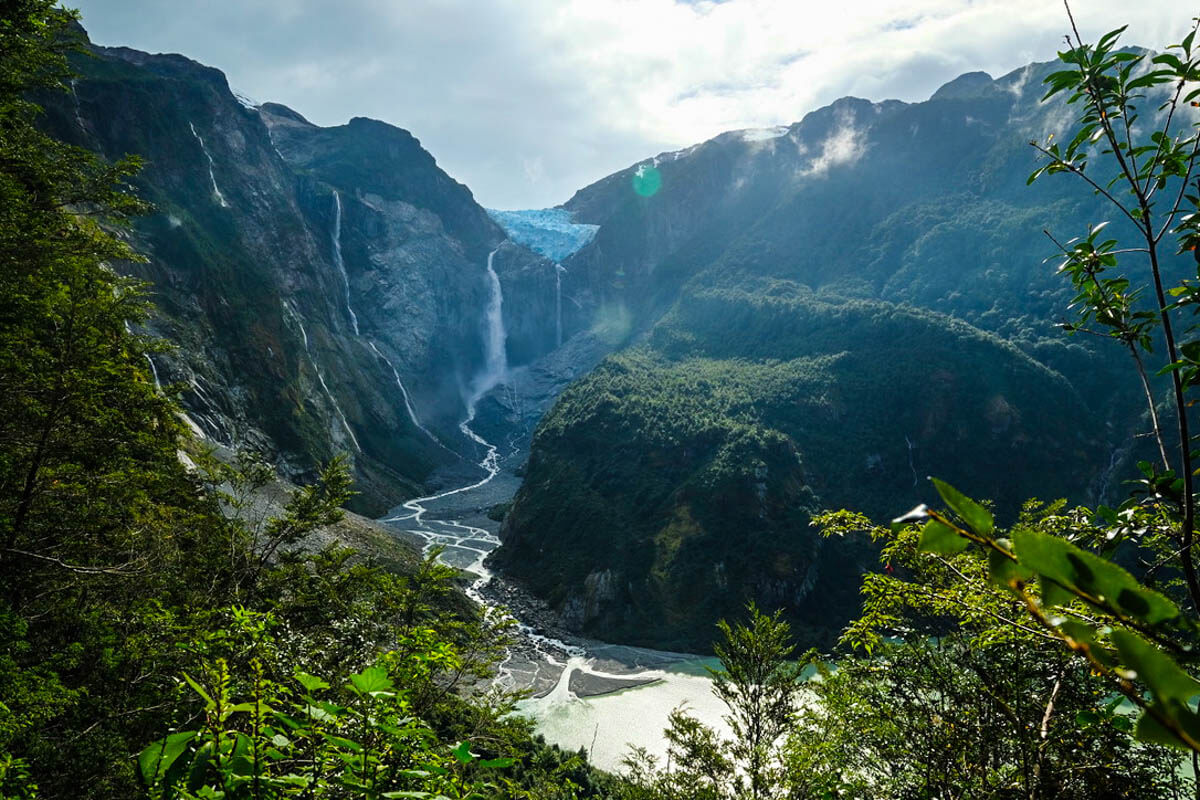
A rainforest and a glacier at the same time really was something I had never experienced.
The Queulat Hanging Glacier is the main adventure draw card for the National Park and this section of the Carretera Austral. The main hike is called the Sendero Mirador de Ventisquero Colgante. It is approximately 3.3km in total and takes around 2.5 hours for the return trip. While the hike is not that long it can be quite steep and muddy at some points. The views of the hanging glacier are quite beautiful at the top and worth the hike.
There is an alternative access point to view the hanging glacier at Laguna Tempanos. This route is a lot more accessible for anyone with mobility issues or for children. If you are in the National Park you could also take the time to do both. This secondary view point is only a 15 minute walk away from the main hike.
Enchanted Forest
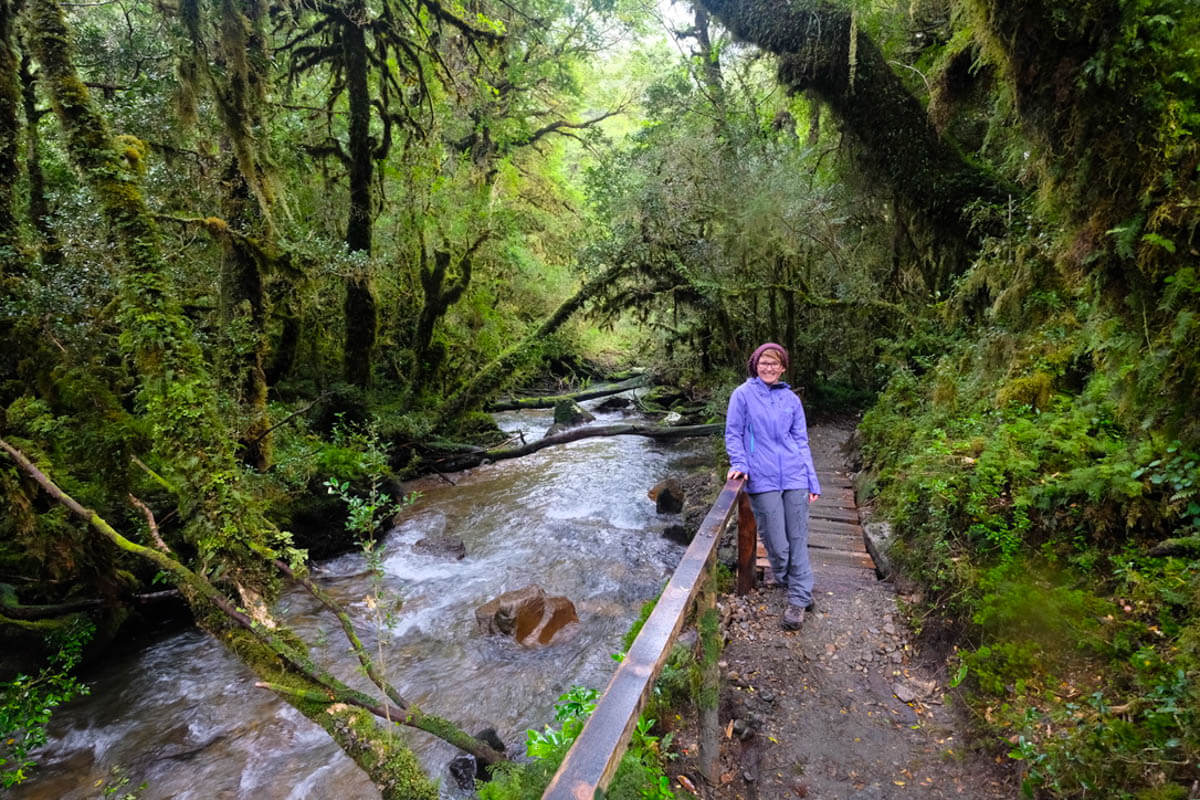
Wandering through a real life fairytale.
Your entrance ticket for the Queulat National Park also includes entrance to the Enchanted Forest Walk. This interesting walk is a little further down the Carretera Austral. It used to be a walk through the forest to a frozen lake. Due to a recent flood in the area, only 800m of the trail is still accessible for now. If you are passing by and are able to stop easily then it is still worth having a look. It really does feel like you are on an enchanted fairytale adventure and it’s something you have to experience for yourself to really know what I mean.
Chilled Adventure in Coyhaique
Coyhaique is the halfway point along the Carretera Austral. It is also the only major city you will find in this whole section of Patagonia. Whilst it doesn’t have much to offer in the way of adventure it is usually a pitstop for most people heading along this highway for resupply and recuperation.
What to Do
Coyhaique offers all the things that most small cities do. Restaurants, major supermarkets, local craft markets, outdoor clothing and camping stores, tourist offices, hostels, camping and nightlife. It is a good spot to take a break from trekking and hitchhiking. It is also a great location to replenish any gear or food necessities. Coyhaique is also one of the only places along the Carretera Austral where you can purchase electronics and other major items so stock up here if necessary!
Where to Stay
There are quite a few options for accommodation while in Coyhaique depending on your budget. There are camp grounds close to the national park, hospedaje’s and also hostels. For the most part the hostel’s are priced fairly average in comparison to the rest of Chile and Patagonia. We paid $8,000.00 CLP ($17.00AUD) for our stay at a hostel / hospedaje reasonably close to the centre of town. Expect to pay around that if you don’t want to camp at the national park which is a little further out of town.
Getting There and Away
There is an airport nearby to Coyhaique that you can fly in and out of. This would be useful for anyone who only wanted to do part of the Carretera Austral. You can also catch buses to and from Coyhaique to the surrounding towns including Puerto Rio Tranquillo to the Souht and Puyuhuapi to the North. The bus timetables and prices vary constantly. You are best to find this out once you get there or from the town you are departing. The tourist office in the centre of town are very helpful when it comes to transit timetables.
There is also a bus to Puerto Ibanez, where you can catch a ferry to Chile Chico. From there you can then cross the border to Los Antiguos in Argentina. This is ideal for anyone wanting to continue to Southern Patagonia on the Argentinian side without visiting the rest of the Carretera Austral.
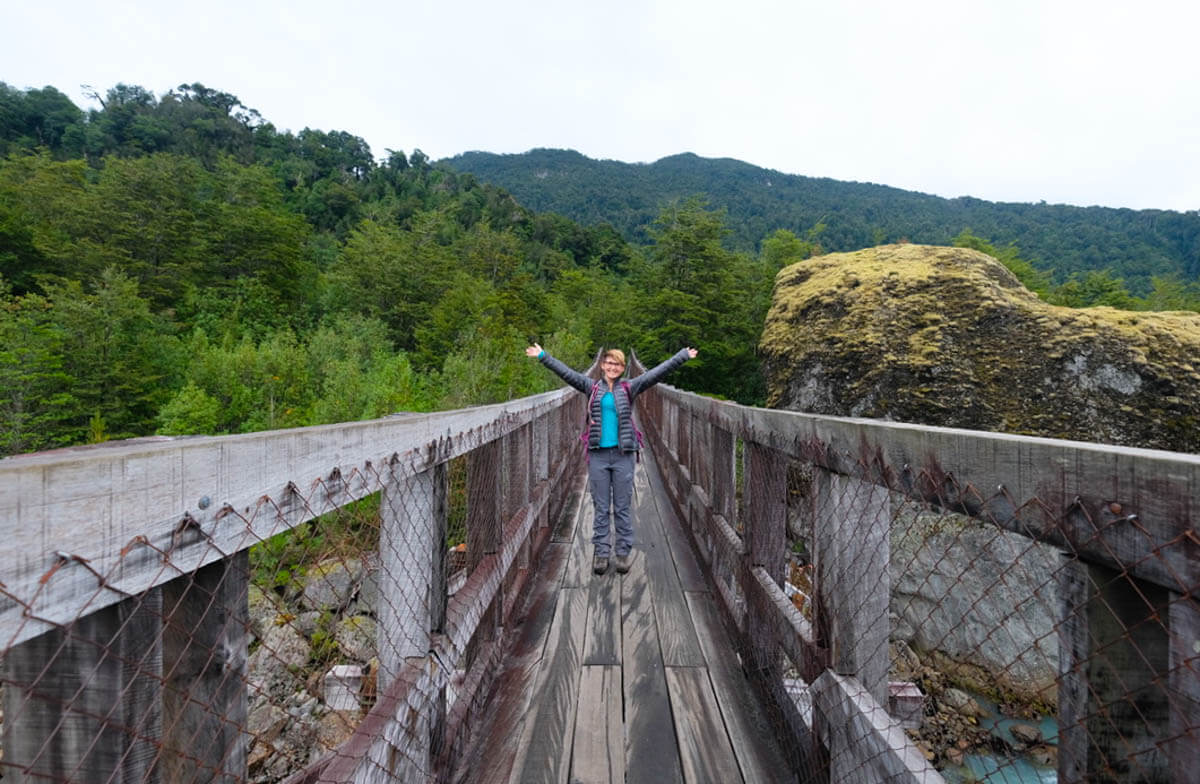
You can never take too many bridge photos! 😉
Travel Insurance
No hiking related itinerary would be complete without travel insurance. While you can take every precaution under the sun to ensure the safety and security of yourself and your belongings, you just never know what is going to happen. That is why I always make sure I have adequate travel insurance before I travel or hike anywhere. For my last three long term adventure trips, my preferred travel insurer has been World Nomads.
If you decide to use them for your next trip or hike and you would like to support this blog, then please make your purchase through the below quote link and I will receive a small commission at no extra cost to you. As always, make sure you read their product disclosure statement and check that it is suitable for your needs before proceeding.
What to Pack
My last piece of advice with regards to adventuring in this area of Patagonia is what to pac. For the day hike options you really only need snacks, water, and layers for potential weather you may encounter. On an average day hike I usually take the following items;
- 18L Osprey Ultralight Stuff Pack
or Osprey 20L Tempest day pack
- Fujifilm X-T2 Camera
, a wide angle lens
and a general purpose / portrait lens
, and accessories
- CamelBak water reservoir
/ Nalgene water bottle
- Snacks (muesli bars, dried fruit and nut, Clif bars
and / or fresh fruit or snacks depending on the length of the hike)
- Water/windproof jacket if the weather turns
— this jacket from Arc’teryx
is excellent quality, or or a jacket from The North Face
- XT Ultralight Packable Down Jacket or Arc’teryx fleece
in case it will be cold at the summit or if completing a sunrise hike
- Headlamp
in case you lose light
- Phone for emergencies and maps.me
- First Aid Kit
- Personal Locator Beacon (PLB)
— depending on how remote your hike will be, although I always carry one regardless
If you are hiking, camping and adventuring in this area of Patagonia as part of a larger trip with multi-day trekking on the agenda then you will need a lot more gear, specifically designed for overnight hiking. I highly recommend heading over and checking out my post about what to pack for multi-day hikes.
That hiking guide provides you with a detailed packing list for clothing, shelter, food and cooking, as well as safety and emergency gear for any multi-day trek. There is a downloadable checklist as well to use the next time you are packing.
Recommended Reads
If you to Patagonia anytime soon, you can also easily access posts about my other favourite hiking destination, Patagonia:
- The 4 Day Trek to Cerro Castillo, on the Carretera Austral in Chile
- Hiking and Camping in Pumálin Park, on the Carretera Austral in Chile
- The Best Hikes in Bariloche, in Northern Patagonia, Argentina
- The Ultimate Guide to Torres Del Paine and The O Circuit, Chile
- The Best Hikes in El Chaltén, Argentina
If you will be travelling on your own and have never solo hiked before, but have been considering it for a while then you should definitely have a look at some of my posts relating to solo hiking:
If you are just after some more reading on Adventure Travel in general, I have grouped all of my posts relating to Adventure into one place.
Save it for Later
If you are headed to Patagonia soon then why not save this guide about adventure in Patagonia on Pinterest? You can share it to Facebook with friends and family as well. If you have been to New Zealand and know of an incredible hike not included here, then please leave it in the comments section below so I can add it to my list for next time. Let me know if you have any questions!
–Girl Seeking Purpose